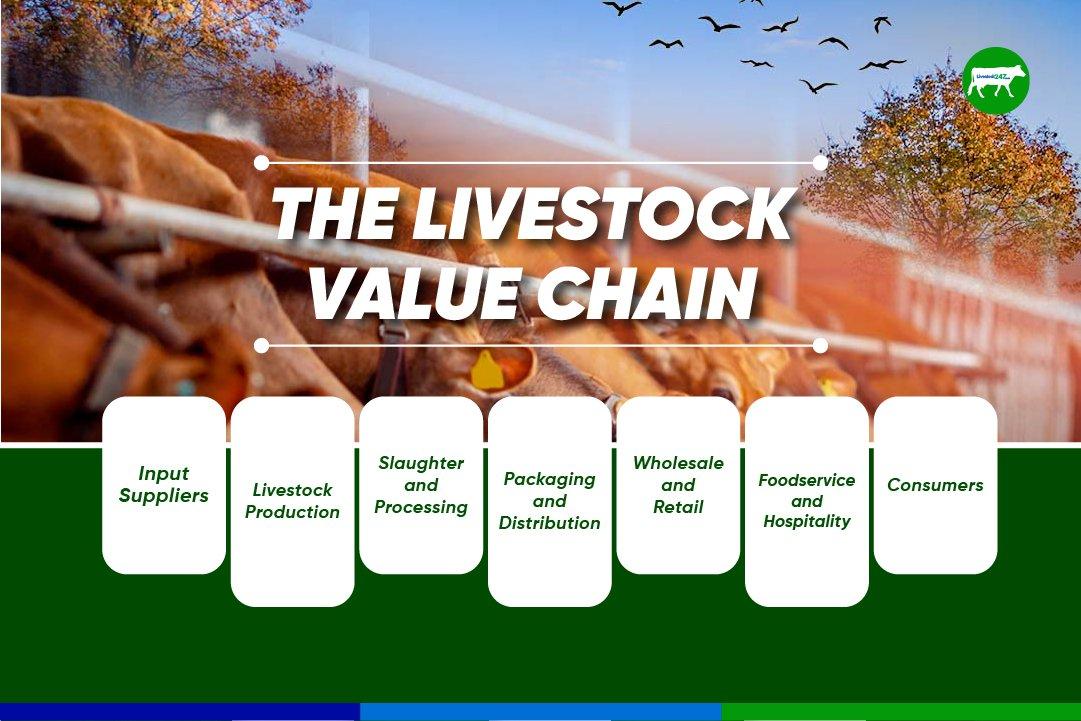Livestock247 - The Livestock Value Chain
The meat value chain, also known as the livestock value chain or the meat production and supply chain, refers to the entire process involved in the production, processing, distribution, and consumptio

The meat value chain, also known as the livestock value chain or the meat production and supply chain, refers to the entire process involved in the production, processing, distribution, and consumption of meat products. It encompasses various stages from farm to fork, involving multiple stakeholders and activities.
Here are the key stages and participants in the meat value chain:
📍 Input Suppliers: This stage involves the provision of inputs such as veterinary services, feed, medications, and technology to livestock producers. Farmers require these resources to raise healthy and productive animals.
📍 Livestock Production: Livestock production involves the actual raising of animals, whether it be for meat, milk, wool, or other products. This stage includes activities such as breeding, feeding, and animal health management.
📍 Slaughter and Processing: Livestock processing involves converting live animals into various products such as meat, dairy, leather, and other by-products. Processing facilities can include slaughterhouses, meatpacking plants, dairy processing plants, and tanneries.
📍 Packaging and Distribution: Once processed, livestock products need to be distributed to retailers, wholesalers, and consumers. This stage involves transportation, storage, and marketing activities to make the products available to the end consumer.
📍 Wholesale and Retail: Retailers play a crucial role in the livestock value chain by making products available to consumers. This stage includes supermarkets, butchers, specialty stores, and other outlets where consumers can purchase livestock products.
📍 Foodservice and Hospitality: The final stage involves consumers purchasing and consuming livestock products. This could include meat, dairy, leather goods, and other items derived from animals.
📍 Consumers: The final stage involves consumers purchasing and consuming livestock products. This could include meat, dairy, leather goods, and other items derived from animals.
📍 Waste Management: Waste management is an important aspect of the livestock value chain. Proper disposal or utilization of by-products and waste generated during processing contributes to environmental sustainability.
It is important to note that the meat value chain can have significant environmental, social, and ethical considerations, including animal welfare, sustainability, and the impact of livestock production on land, water, and greenhouse gas emissions. These factors have led to increased interest in alternative meat sources, such as plant-based meat substitutes or lab-grown meat, as potential solutions to address these concerns.
Each stage is interconnected, and the efficiency and sustainability of the chain depend on the collaboration and coordination among various stakeholders, including farmers, input suppliers, processors, distributors, retailers, and consumers. Additionally, technology, regulatory authorities, quality control agencies, transportation providers, and market intermediaries also contribute to ensuring food safety, traceability, and compliance with regulations and can influence the overall performance of the livestock value chain. Sustainable practices, animal welfare considerations, and food safety are also increasingly important aspects of the modern livestock value chain.
Deborah Dairo
Deborah Dairo is the content strategist for Livestock247
No comments yet. Login to start a new discussion Start a new discussion